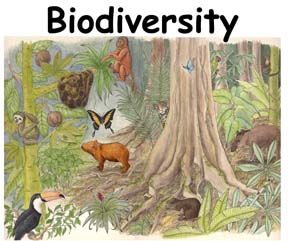

Biodiversity is not just how many animals and plants there are, but the different kinds of animals and plants there are. Each different habitat, from rainforests to deserts to grasslands to polar regions, each has different kinds of animals, plants, fungus, etc.
Biodiversity is important! Every living thing (organism) in an ecosystem, whether it is a giant elephant or a tiny bacteria, has a job to do to help keep things healthy and in balance. Many living things share jobs in their ecosystem. For example, there are many different kinds of predators in every ecosystem – not just one. The overlapping jobs help act as a back up, in case there is drought, disease, floods or fire and some living things die off. This complex weaving of lives together has formed – evolved – over a long period of time. Even the smallest bacteria in the soil plays its part. When species begin to disappear from an ecosystem, the balance depends on fewer and fewer living things. It increases the chances that the whole ecosystem can go out of balance and collapse.
An example of the danger of losing species biodiversity can be shown with many farm crops – like modern corn. American farmers, over many generations, grew the best tasting sweet corn by breeding and planted only the purest strains of sweet corn year after year. This is called growing a “monoculture.” It seemed like the right thing to do. People like the sweetest corn, so there was no need to keep around many strains that weren't as sweet. Right? That is what the farmers thought too. Then something happened. A disease called corn smut attacked the crop. The corn had been bred to be so specific, so much the same, that it had little resistance to the fungus. The entire corn was destroyed. They didn't even have any seeds saved from the older, stronger, less sweet strains of corn. It was a disaster.
________________________________________________________________________________________________
Testing and Assessment
Assess content comprehension about Topics about Endangered Species with the Mutiple Choice Test.
Assess student knowledge of which animals are endangered with the Endangered Animal Labeling Page.
Use the Endangered Animal Coloring Page as a model to reinforce this knowledge.
________________________________________________________________________________________________
Farm researchers went to Mexico, searched for and found wild maize from which corn was descended. They found the gene that resisted smut and bred it back into the corn. Now farmers plant a variety of crops and strains to avoid the danger of crops losing their healthy biodiversity.
When you research information you must cite the reference. Citing for websites is different from citing from books, magazines and periodicals. The style of citing shown here is from the MLA Style Citations (Modern Language Association).
When citing a WEBSITE the general format is as follows.
Author Last Name, First Name(s). "Title: Subtitle of Part of Web Page, if appropriate." Title: Subtitle: Section of Page if appropriate. Sponsoring/Publishing Agency, If Given. Additional significant descriptive information. Date of Electronic Publication or other Date, such as Last Updated. Day Month Year of access < URL >.
Amsel, Sheri. "Biodiversity – Who's Out There?" Exploring Nature Educational Resource ©2005-2024. December 13, 2024
< http://mail.exploringnature.org/db/view/639 >

